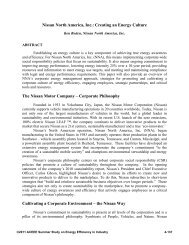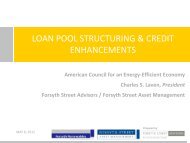Energy and Water Performance Benchmarking in the Retail Sector ...
Energy and Water Performance Benchmarking in the Retail Sector ...
Energy and Water Performance Benchmarking in the Retail Sector ...
You also want an ePaper? Increase the reach of your titles
YUMPU automatically turns print PDFs into web optimized ePapers that Google loves.
outcomes are targeted at greenhouse emissions, but can equally translate to energy consumption.<br />
Certa<strong>in</strong>ly, <strong>in</strong> <strong>the</strong> Australian market, <strong>the</strong> ratio of greenhouse emissions between electricity <strong>and</strong><br />
natural gas (0.94:0.21kgCO2-e/kWh) is similar to <strong>the</strong> ratio of <strong>the</strong>ir typical costs<br />
($0.15:$0.04/kWh), mak<strong>in</strong>g this benchmark relevant for both emissions <strong>and</strong> energy cost.<br />
Key to this paper are <strong>the</strong> boundaries of a shopp<strong>in</strong>g centre. Initially, <strong>the</strong> study was aimed<br />
at <strong>the</strong> total retail sector. However, through early rounds of analysis, it was found that <strong>the</strong>re was<br />
too much diversity <strong>in</strong> tenant <strong>in</strong>stallations <strong>and</strong> usage patterns between different tenant types, such<br />
as supermarkets, department stores, <strong>and</strong> specialty stores. Fur<strong>the</strong>rmore, while water is typically<br />
metered through a master meter for each site, electricity is typically metered direct from <strong>the</strong><br />
electricity retailer to <strong>the</strong> tenants, which makes <strong>the</strong> collection of this data more challeng<strong>in</strong>g due to<br />
<strong>the</strong> substantially <strong>in</strong>creased numbers of survey respondents. <strong>Benchmark<strong>in</strong>g</strong> of energy use with<strong>in</strong><br />
<strong>the</strong> tenanted spaces is an ongo<strong>in</strong>g area of research for this project. The results with<strong>in</strong> this paper<br />
refer to <strong>the</strong> entire site consumption for water benchmark<strong>in</strong>g, but only to <strong>the</strong> “base build<strong>in</strong>g” or<br />
l<strong>and</strong>lord services with<strong>in</strong> shopp<strong>in</strong>g centres for greenhouse benchmark<strong>in</strong>g.<br />
Background on NABERS, <strong>and</strong> <strong>the</strong> Context for this Study<br />
NABERS (www.nabers.com.au) is a performance rat<strong>in</strong>g scheme – <strong>in</strong> simple terms,<br />
measur<strong>in</strong>g actual production aga<strong>in</strong>st actual resource consumption <strong>and</strong> rank<strong>in</strong>g it aga<strong>in</strong>st average<br />
performance <strong>in</strong> <strong>the</strong> market. It is expressed as a 0-5 star scale, <strong>in</strong> half star <strong>in</strong>crements. 2.5 stars<br />
represents average performance <strong>in</strong> <strong>the</strong> <strong>in</strong>dustry, while 5 stars represents an aspirational level of<br />
achievement, beyond what is be<strong>in</strong>g delivered by <strong>in</strong>dustry at <strong>the</strong> time <strong>the</strong> rat<strong>in</strong>g b<strong>and</strong>s are<br />
constructed. Typically, 5 stars represents a reduction <strong>in</strong> resource usage of 60% from average, but<br />
varies slightly between build<strong>in</strong>g types. Key to <strong>in</strong>terpret<strong>in</strong>g NABERS rat<strong>in</strong>gs is that it is based<br />
upon real, measured performance, ra<strong>the</strong>r than predicted or simulated performance. The<br />
experience <strong>in</strong> Australia over <strong>the</strong> last 10 years has shown that <strong>the</strong>re is a non trivial gap between<br />
predicted performance <strong>and</strong> achieved performance (Bannister, 2009).<br />
Australia has had office energy performance rat<strong>in</strong>gs available for over 10 years. Rat<strong>in</strong>gs<br />
were available under <strong>the</strong> Australian Build<strong>in</strong>g Greenhouse Rat<strong>in</strong>g (ABGR) scheme, which was<br />
later absorbed <strong>in</strong>to <strong>the</strong> National Australian Built Environment Rat<strong>in</strong>g Scheme (NABERS), as<br />
o<strong>the</strong>r performance rat<strong>in</strong>gs were released. Currently <strong>the</strong> NABERS program <strong>in</strong>cludes energy,<br />
water, waste <strong>and</strong> <strong>in</strong>door environment rat<strong>in</strong>gs for office build<strong>in</strong>gs, energy <strong>and</strong> water rat<strong>in</strong>gs for<br />
hotels, shopp<strong>in</strong>g centres, houses <strong>and</strong> hospitals, with rat<strong>in</strong>gs for schools <strong>and</strong> data centres currently<br />
under development. The data <strong>and</strong> benchmarks with<strong>in</strong> this paper formed <strong>the</strong> basis for NABERS<br />
for Shopp<strong>in</strong>g Centres.<br />
NABERS has been widely accepted with<strong>in</strong> <strong>the</strong> office market, with over 60% of <strong>the</strong> total<br />
floor area <strong>in</strong> Australia hav<strong>in</strong>g been assessed at least once (DECCW, 2009). NABERS has had a<br />
significant impact on <strong>the</strong> Australian market, with it now be<strong>in</strong>g l<strong>in</strong>ked to rental premiums, longer<br />
leases <strong>and</strong> rental reviews through green leases (DECCW, 2009). Dem<strong>and</strong> from tenants has<br />
generated a substantial premium for build<strong>in</strong>gs operat<strong>in</strong>g at 4.5 or 5 stars, with this dem<strong>and</strong> (<strong>and</strong><br />
contract risk) be<strong>in</strong>g passed on to developers <strong>and</strong> design teams.<br />
The prevalence of NABERS rat<strong>in</strong>gs <strong>in</strong> <strong>the</strong> office environment is highlighted by <strong>the</strong><br />
proposed m<strong>and</strong>atory disclosure legislation currently before parliament (DEWHA, 2009). This<br />
legislation requires <strong>the</strong> disclosure of actual energy performance over <strong>the</strong> last 12 months for office<br />
build<strong>in</strong>gs of greater than 2000m 2 (22,000ft 2 ) net lettable area at key po<strong>in</strong>ts <strong>in</strong> <strong>the</strong>ir life cycle,<br />
©2010 ACEEE Summer Study on <strong>Energy</strong> Efficiency <strong>in</strong> Build<strong>in</strong>gs<br />
3-2




